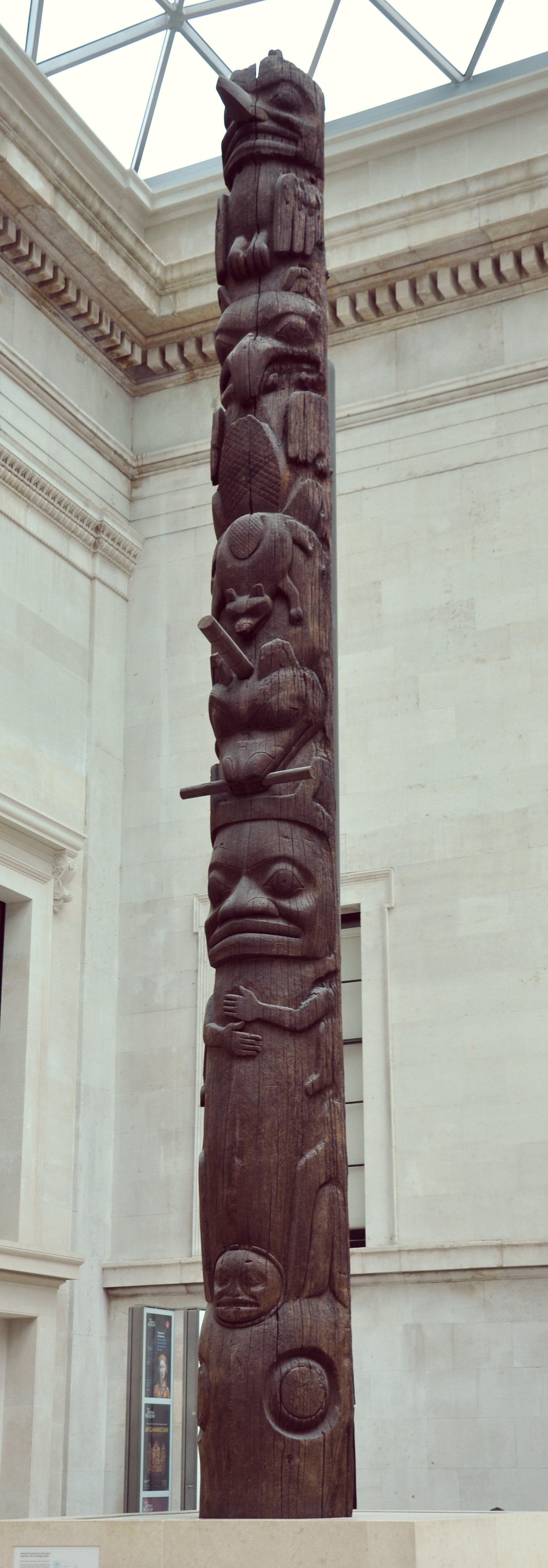The Haisla are a First Nation in Canada. The Haisla Nation is made up of two historic bands, the Kitamaat of upper Douglas Channel and Devastation Channel and the Kitlope of upper Princess Royal Channel and Gardner Canal in British Columbia. The Kitamaat call themselves Haisla ("dwellers downriver"); and the Kitlope, Henaaksiala ("dying off slowly"), a reference to their traditional longevity. The official designations Kitamaat ("people of the snow") and Kitlope ("people of the rocks") were adopted from the names used by the Tsimshian to refer to their Haisla neighbours.

Traditional Territory
Haisla territory is in the northwest coast of British Columbia. Today, the Kitamaat Village ( see also Kitimat) at the head of the Douglas Channel is the Haisla’s home community. (See also Indigenous Territory and Northwest Coast Indigenous Peoples in Canada.)
Population
No formal estimates of precontact population exist, although Haisla oral tradition asserts that the Kitamaat and Kitlope each numbered about 1,000. Epidemics and diseases brought by Europeans reduced that population, and after the 1918 influenza pandemic, fewer than 300 survived.
The decline slowed around 1930; by 1986 the population of the combined bands had reached 1100 and by 1996 the Kitamaat population was 1364 (figures for the Kitlope were not available). Population estimates are also difficult due to additional persons of Haisla ancestry who lost their status. (See also Indian Act and Indian Status.)
As of 2021, the Government of Canada counts 1,990 registered members of the Haisla nation.
Language
The Haisla language is the northernmost of the North Wakashan division of the Wakashan language. It is also one of the six language families within the Northwest Coast Language Families which is closely related to Kwak'wala and Heiltsuk. (See also Indigenous Languages in Canada.)
Clan System
Unlike those of other Wakashan-speaking nations, the Kitamaat and Kitlope social system was based on the matrilineal clan. This principle was also followed by the Tsimshian nations, with whom the Haisla enjoyed close economic and social relations.
Originally there were eight clans (Eagle, Beaver, Raven, Crow, Killer Whale, Salmon, Wolf and Frog), each composed of family units or lineages, occupying one or more communal dwellings that housed up to 30 individuals. With population decline after the 1918 influenza pandemic, the Wolf and Frog clans disappeared entirely.
The highest-ranking members of each house or lineage formed a council of nobles for the clan chief, who himself acted as counsellor to the nation chief. Each clan controlled its own resource sites within the general traditional territory, and each occupied an independent winter village.
The clan system remains an important part of Haisla society and culture.
History
With population decline after European contact, the survivors of Haisla clans united to occupy a common winter village (the Kitamaat Village) and co-operated economically and socially, as in the planning and amassing of wealth for the potlatch. Eventually the whole nation began to occupy the same village, although clan distinctions and linkages remain.
Missionaries and government agents believed that certain aspects of traditional Indigenous culture would prevent the assimilation of Indigenous peoples to Euro-Canadian culture and should therefore be banned. They used their influence to force the abandonment of feasts and dancing. Additionally, traditional communal houses were pulled down (see also Plank House), and the children were forbidden to speak the Haisla language. In 1884, the Indian Act banned the potlatch; it was not reinstated until 1951. During the same period, the decline in population shattered the clans and lineages and disrupted orderly lines of succession to titles and property in the traditional social order.
The remoteness of some villages, situated far up northern inlets, enforced isolation on the Kitimaat and Kitlope until the 1890s, when a mission and residential school were established at Kitamat. After several decades of strain and dislocation, a culture has emerged that combines elements of both their traditional heritage and Euro-Canadian culture.
Culture
The non-profit Na Na Kila Institute was established to support the conservation, stewardship and development of the ancestral lands and culture of the Haisla Nation.
In 2006, the Na Na Kila Institute helped bring back to Canada a Haisla totem pole. This was the first pole ever repatriated from overseas. (See also Repatriation of Artifacts.) The pole was returned to the UBC Museum of Anthropology in Vancouver from the Museum of Ethnography in Stockholm, Sweden. In 1876, Chief G'psgolox erected the totem to commemorate the Kitlope people who died during the smallpox epidemic. In 1929, the traditional mortuary pole, G'psgolox, was removed from a Haisla village in Mis'kusa and was missing for over sixty years; however, its memory was retained in the Haisla oral traditions. In 1991, the pole was discovered in Sweden and after years of negotiations, and 77 years in a foreign museum, the pole was returned to Kitamaat, British Columbia, on 1 July 2006. A second pole was erected in Misk'usa, where the original pole was located. As part of the repatriation agreement, the Haisla carved a replica pole for the Swedish museum.
The loss of the totem pole, its discovery and its repatriation were documented in the film Totem: The Return of the G'psgolox Pole, by Gil Cardinal for the National Film Board.
Contemporary Life
After careful review, the Haisla Nation has become involved in LNG (liquified natural gas) projects. (See also Natural Gas in Canada.) The plant site of LNG Canada operates within Haisla territory. (See also Pipelines in Canada.)

 Share on Facebook
Share on Facebook Share on X
Share on X Share by Email
Share by Email Share on Google Classroom
Share on Google Classroom




